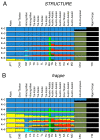Genetic evidence supports linguistic affinity of Mlabri--a hunter-gatherer group in Thailand
- PMID: 20302622
- PMCID: PMC2858090
- DOI: 10.1186/1471-2156-11-18
Genetic evidence supports linguistic affinity of Mlabri--a hunter-gatherer group in Thailand
Abstract
Background: The Mlabri are a group of nomadic hunter-gatherers inhabiting the rural highlands of Thailand. Little is known about the origins of the Mlabri and linguistic evidence suggests that the present-day Mlabri language most likely arose from Tin, a Khmuic language in the Austro-Asiatic language family. This study aims to examine whether the genetic affinity of the Mlabri is consistent with this linguistic relationship, and to further explore the origins of this enigmatic population.
Results: We conducted a genome-wide analysis of genetic variation using more than fifty thousand single nucleotide polymorphisms (SNPs) typed in thirteen population samples from Thailand, including the Mlabri, Htin and neighboring populations of the Northern Highlands, speaking Austro-Asiatic, Tai-Kadai and Hmong-Mien languages. The Mlabri population showed higher LD and lower haplotype diversity when compared with its neighboring populations. Both model-free and Bayesian model-based clustering analyses indicated a close genetic relationship between the Mlabri and the Htin, a group speaking a Tin language.
Conclusion: Our results strongly suggested that the Mlabri share more recent common ancestry with the Htin. We thus provided, to our knowledge, the first genetic evidence that supports the linguistic affinity of Mlabri, and this association between linguistic and genetic classifications could reflect the same past population processes.
Figures







References
-
- Pookajorn S. The Phi Tong Luang (Mlabri): A hunter-gatherer group in Thailand. Bangkok: Odeon Store Printing House; 1992.
-
- Rischel J. Minor Mlabri, a hunter-gatherer language of northern Indochina. Copenhagen: Museum Tusculanum; 1995. - PubMed
-
- Schliesinger J. Ethnic Groups of Laos. Vol. 2. Bangkok: White Lotus Press; 2003.
-
- Wikipedia_contributors. 'Mlabri people', Wikipedia, The Free Encyclopedia. 2009. http://en.wikipedia.org/wiki/Mlabri_people
-
- Wikipedia_contributors. 'Mlabri language', Wikipedia, The Free Encyclopedia. 2009. http://en.wikipedia.org/wiki/Mlabri_language
Publication types
MeSH terms
LinkOut - more resources
Full Text Sources
Research Materials
Miscellaneous

